Egypt Alexandrite Lasers Market Outlook to 2030
By System Type, By Application, By End User, By Price Tier, By Financing Model, and By Region
- Product Code: TDR0242
- Region: Asia
- Published on: August 2025
- Total Pages: 110
Introducing the World's FirstPay-Per-Section Market Reports
Why pay for the full report when you need just a part?
Start Building Your Report
Scroll down to see available sections
Report Summary
The report titled “Egypt Alexandrite Lasers Market Outlook to 2030 – By System Type, By Application, By End User, By Price Tier, By Financing Model, and By Region” provides a comprehensive analysis of the Alexandrite laser industry in Egypt. The report covers an overview and genesis of the industry, overall market size in terms of revenue, detailed market segmentation, emerging trends and technological developments, regulatory and licensing framework, clinic-level profiling, issues and challenges, and a competitive landscape including competition scenario, cross-comparison parameters, opportunities and bottlenecks, and company profiling of major players in the Alexandrite laser market. The report concludes with future market projections based on installed base expansion, technology adoption patterns, end-user categories, financing structures, regional distribution, and cause-and-effect relationships. It also highlights success case studies, investment strategies, and key caution areas shaping the growth trajectory of the Egypt Alexandrite Lasers Market.
Egypt Alexandrite Lasers Market Overview and Size
The Egypt Alexandrite Lasers market is valued at approximately USD 48.7 million in 2024. This market is driven by increasing demand for cosmetic dermatology solutions, expanding medical-aesthetic tourism into Egypt’s Red Sea and Cairo corridors, and rising patient willingness to invest in long-term hair removal and pigmentation treatments using efficacious, minimally invasive Alexandrite technology.
Greater Cairo and Alexandria dominate the Egypt Alexandrite Lasers market due to high densities of aesthetic dermatology clinics, stronger consumer affluence, and greater exposure to beauty-centric urban culture. Additionally, tourist cities along the Red Sea and Sinai enjoy a proportionally higher demand from international clientele seeking advanced laser procedures, enhancing installed-base growth in these regions.
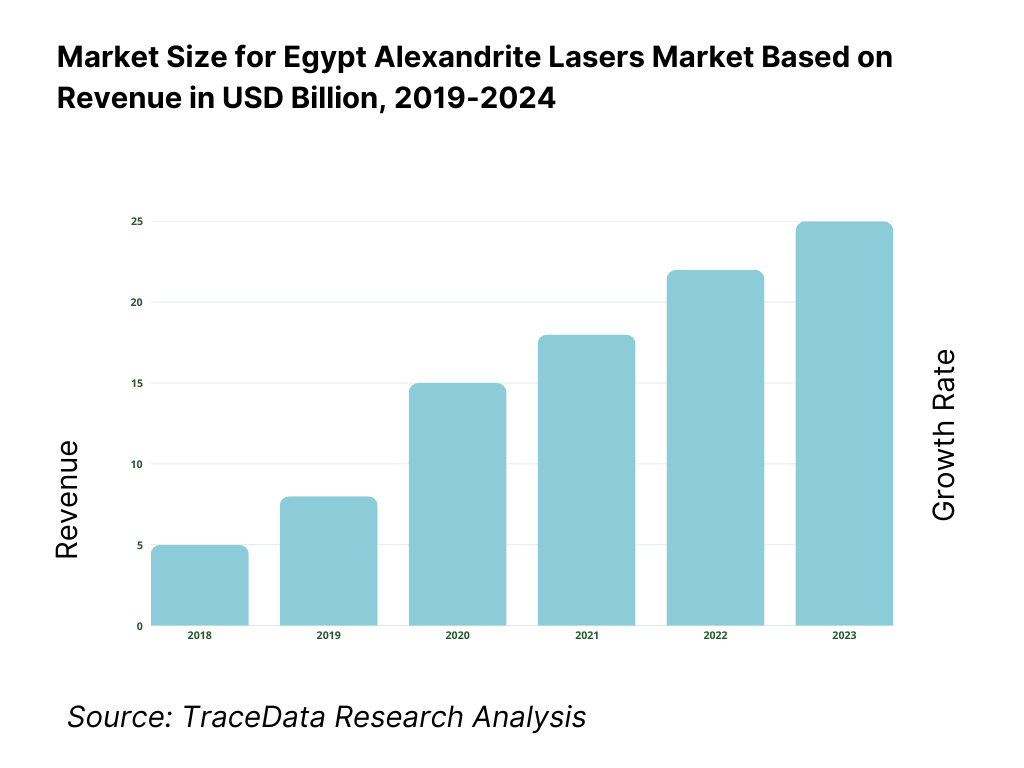
What Factors are Leading to the Growth of the Egypt Alexandrite Lasers Market:
Expanding urban consumer base, digital reach and reliable power: Egypt’s population stands at 116,538,258 and its economy produced USD 389.06 billion in output, creating a large, cash-oriented consumer base for aesthetic clinics to market Alexandrite laser services. Digital discovery and lead generation are increasingly efficient because 73 of residents used the internet and Egypt hosted 82.2 secure internet servers per million people, underpinning e-commerce, clinic CRMs, and omnichannel patient funnels. Crucially for high-wattage capital equipment, national power access reached 100.0 of people, supporting uptime for lasers in dermatology centers and day-surgery suites. These fundamentals directly raise consultation volumes in Cairo, Giza, and Alexandria—where online appointment traffic and power reliability matter most for device utilization.
Tourism inflows and consumer cash channels that feed procedure demand: The aesthetic segment benefits from destination care and add-on procedures for travelers and expatriates. Egypt received 15.7 million inbound tourists, reinforcing year-round patient inflows in resort corridors (Red Sea, Luxor–Aswan) and Alexandria. Household purchasing power is also buoyed by cross-border money flows: personal remittances credited to Egypt reached USD 19,532,100,000, supporting discretionary outlays such as laser hair removal and pigment correction among families receiving funds from relatives working abroad. Together with a population of 116,538,258, these cash channels translate into fuller appointment books for clinics equipped with Alexandrite platforms and adjunct cooling systems.
Health-system modernization and private out-of-pocket dynamics: Elective dermatology remains largely self-funded, and macro health spending gives context to what clinics can price and finance. Egypt’s current health expenditure per capita measured USD 170.98, while out-of-pocket health expenditure per capita was USD 92.04—evidence that retail health purchases are commonplace even as insurance penetration expands. Quality and safety programs are also scaling: Egypt’s accreditation authority (GAHAR) cites the legal framework for facility oversight and patient rights, anchoring investment in compliant laser rooms, smoke evacuation, and staff training. With 100.0 access to electricity and modernizing urban hospitals and polyclinics, providers can plan higher device utilization hours and multi-room laser suites without frequent service interruptions.
Which Industry Challenges Have Impacted the Growth of the Egypt Alexandrite Lasers Market:
Foreign-currency constraints and import clearance complexity: Alexandrite lasers are overwhelmingly imported, making acquisition cycles sensitive to FX availability and customs throughput. The Central Bank of Egypt reported a current account deficit of USD 20,806.6 million in the 2023/24 fiscal year, underlining hard-currency tightness. Simultaneously, Suez Canal revenues fell to USD 3.991 billion from USD 10.25 billion, reducing a key source of foreign exchange. Importers must also secure EDA import approvals and supply formal documentation (invoices, free-sale/CE evidence, and ISO 13485:2016 compliance) for device release. These macro and procedural realities lengthen tender cycles, increase pre-shipment finance needs, and can delay device commissioning and warranty start dates in hospital and clinic projects.
High household out-of-pocket spend meets elevated inflation: Retail health purchases dominate elective dermatology, but real incomes are pressured by consumer prices. Out-of-pocket health expenditure per capita reached USD 92.04, while headline inflation printed 28.3—dampening discretionary wallets and raising clinic input costs (consumables, cooling tips, eyewear, service contracts). Clinics serving the mass market must therefore re-engineer packages, financing, and patient journeys to defend conversion rates. With a national population of 116,538,258, demand is large but price-sensitive; financing (BNPL), loyalty bundles, and capacity pooling are increasingly necessary to keep Alexandrite systems running at sustainable booking densities when inflation squeezes consumer spend and raises working-capital needs for consumables and spares.
Data-security maturity and cyber-readiness gaps for connected clinics: Digital intake forms, EMRs, and device service telemetry raise the bar for cybersecurity in aesthetic chains. Egypt hosted 82.2 secure internet servers per million people versus a world figure of 16,379—a stark gap that elevates risk around patient data, payment tokens, and connected device interfaces in mid-sized providers. Although 73 of residents used the internet, the low server density signals thinner encryption infrastructure for local hosting, compelling clinics to invest in secure cloud, tokenized payments, and periodic penetration testing before integrating remote service modules on Alexandrite platforms. This technology posture is increasingly important as vendors push software updates and analytics over the network to optimize fluence settings and uptime.
What are the Regulations and Initiatives which have Governed the Market:
Product registration with the Egyptian Drug Authority (EDA): Medical lasers marketed for therapeutic/aesthetic use must be registered with the EDA before import and commercialization. Dossiers typically include device classification, clinical evidence, a free-sale/marketing certificate from a recognized reference market, and ISO 13485:2016 quality compliance by the manufacturer. EDA guidance clarifies that all classes—including non-sterile Class I, IIa/IIb, and III devices—require registration; distributors must hold valid local authorizations reflective of their supply role. For new brands and upgraded models, pre-clearance timelines should be built into commercialization plans, with labeling and UDI alignment to avoid relabeling at customs. These requirements affect launch sequencing and should be integrated with clinic procurement calendars.
Import approvals, customs release, and factory registration rules: After registration, each shipment requires EDA import approval and a complete customs file (formal request, invoices, country of origin, HS coding, and supporting certificates) for port release. In parallel, Egypt maintains a factory/trademark registration regime under Ministerial Decree 43/2016, amended by Decree 195/2022, obligating certain foreign manufacturers and brand owners to enroll with GOEIC so commercial imports can be cleared. Distributors of Alexandrite lasers must therefore coordinate three layers—device registration, importer licensing, and factory/trademark registry status—well before shipment to avoid demurrage and preserve installation schedules tied to clinic openings.
Facility licensing, private-sector participation and accreditation: Private clinics and day-care surgical centers offering laser services operate under the health-facility licensing regime and evolving investment rules. Egypt enacted Law No. 87 of 2024, widening private participation in establishing and operating healthcare facilities—relevant to chain expansion and device fleet deployments. Accreditation oversight by GAHAR references the legal framework for facility governance and patient rights, steering standards for laser rooms (safety signage, eyewear, plume control, staff training). Providers planning multi-site rollouts should sequence device purchases around licensing milestones and accreditation audits to ensure procedures can legally commence upon installation.
Egypt Alexandrite Lasers Market Segmentation
By Application: The Egypt Alexandrite Lasers market is segmented by application into hair removal, pigmented lesion treatment, tattoo removal, and skin rejuvenation. Currently, hair removal holds the dominant share of the application-market in 2024. This dominance stems from its widespread acceptance in both local and tourist segments, consistent repeat-session demand, and higher per-session pricing compared to other uses. Aesthetic clinics prioritize hair removal as a staple service that attracts repeat clients, making equipment utilization and ROI faster. Tourists often opt for package deals that include hair removal, reinforcing hair removal as the primary driver in this application segment.
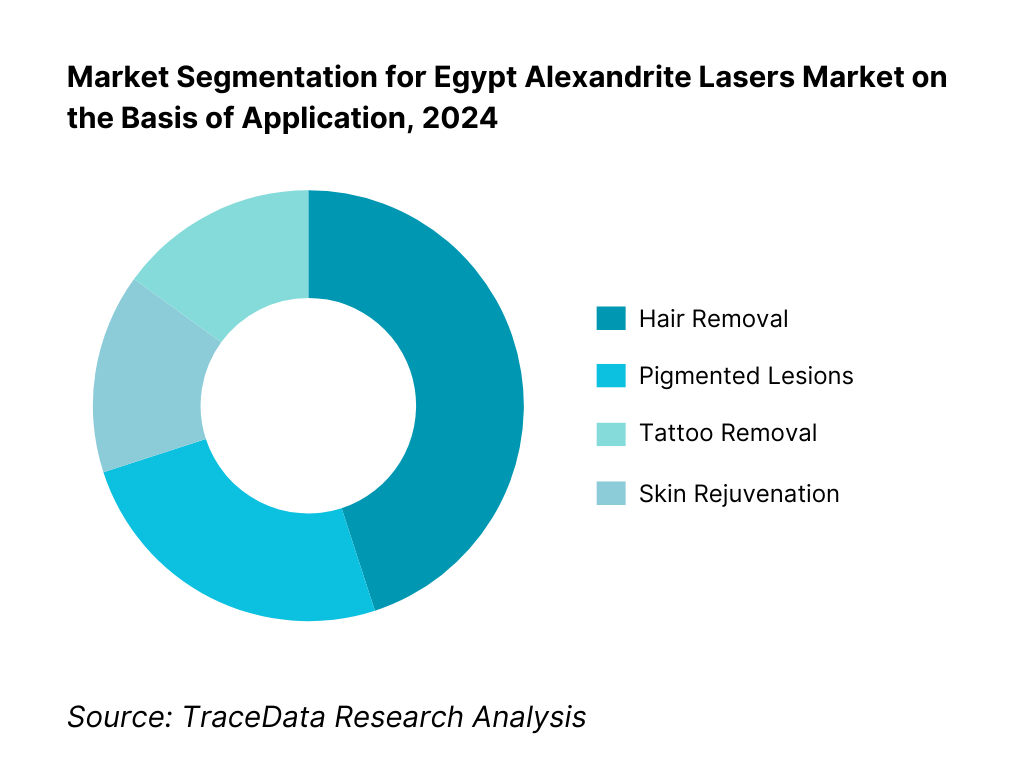
By Customer Type: The market is segmented into dermatology clinics, med-spas/aesthetic chains, hospital departments, and teaching/training centers. Dermatology clinics dominate market share in 2024. This is due to their specialized focus, established patient base, and capacity for repeat treatments. They are more likely to invest in high-spec Alexandrite systems with strong ROI and offer a broader service portfolio. These clinics often host well-known dermatologists who influence treatment adoption trends and serve both local and medical tourist clients. Their smaller footprint compared to hospitals also allows flexibility in marketing and pricing strategies, reinforcing their dominance in Egypt’s market.
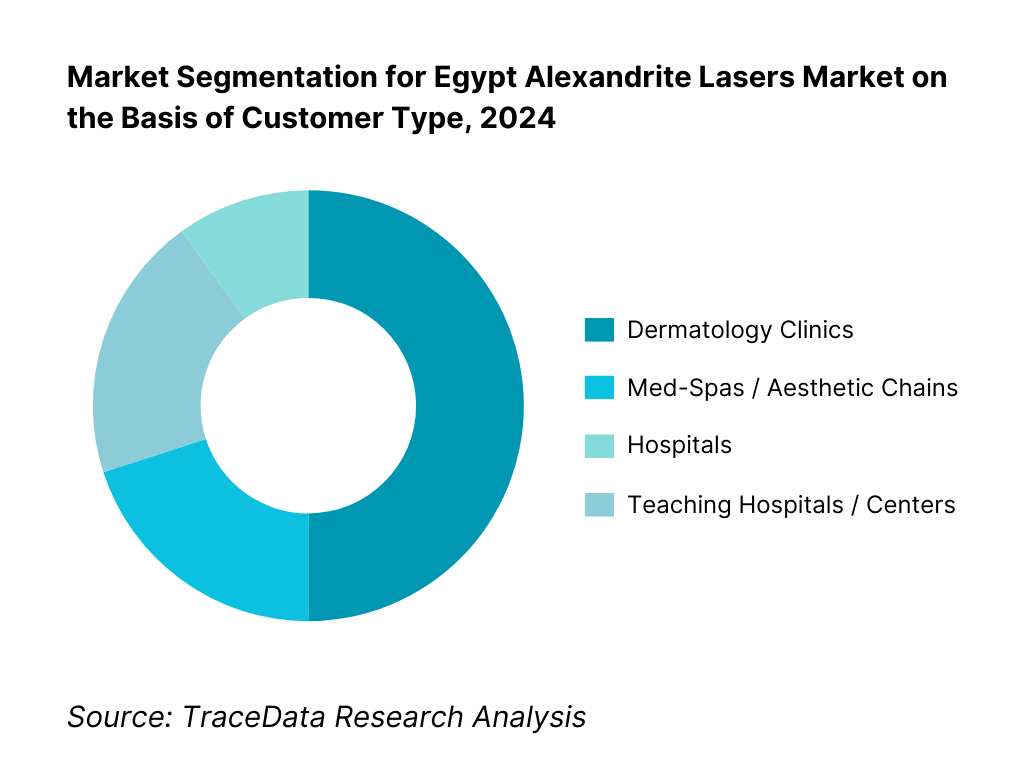
Competitive Landscape in Egypt Alexandrite Lasers Market
The Egypt Alexandrite Lasers market is concentrated around several reputable global OEMs, supported by regional importers and authorized distributors. This consolidation underscores the strong influence these major brands have, particularly in shaping clinical standards, service reliability, and technology adoption. Clinics and hospitals rely on recognized OEMs for performance, warranty, and after-sales support, reinforcing their market dominance.
Name | Founding Year | Original Headquarters |
Candela | 1970 | Massachusetts, USA |
Cynosure | 1991 | Massachusetts, USA |
DEKA (El.En.) | 1991 | Florence, Italy |
Quanta System | 1985 | Milan, Italy |
Cutera | 1998 | California, USA |
Lutronic | 1997 | Goyang, South Korea |
Lumenis | 1966 | Yokneam, Israel |
Asclepion | 1991 | Jena, Germany |
Lynton | 1994 | Cheshire, UK |
WONTECH | 1999 | Daejeon, South Korea |
Bison Medical | 2002 | Seoul, South Korea |
Light Age | 1986 | New Jersey, USA |
Ilooda | 2006 | Suwon, South Korea |
Beijing Sincoheren | 1999 | Beijing, China |
DDC Technologies | 2000 | Shenzhen, China |
Some of the Recent Competitor Trends and Key Information About Competitors Include:
Candela: As one of the most recognized Alexandrite laser manufacturers, Candela expanded its distribution presence in Egypt in 2024 by strengthening after-sales service partnerships and introducing newer Gentle series upgrades, which improved device reliability and ROI for high-volume clinics.
Cynosure: Known for its dual-wavelength laser platforms, Cynosure launched additional clinical training programs in Cairo and Alexandria during 2024, ensuring dermatologists are better equipped to handle complex pigmentation and vascular cases.
DEKA (El.En. Group): Specializing in Alexandrite and diode hybrids, DEKA promoted its Motus Moveo technology across Egypt in 2024, highlighting safer treatments for darker skin types, a key factor in local market adoption.
Quanta System: With a strong reputation for mixed-technology systems, Quanta System collaborated with regional distributors in 2024 to introduce financing schemes, helping smaller clinics in Egypt’s Delta and Upper Egypt regions access premium Alexandrite platforms.
Lutronic: A major player in dermatology devices, Lutronic expanded the reach of its Clarity II platform in Egypt in 2024, emphasizing its IntelliTrak and temperature-sensing technologies to appeal to high-end aesthetic centers targeting affluent clients.
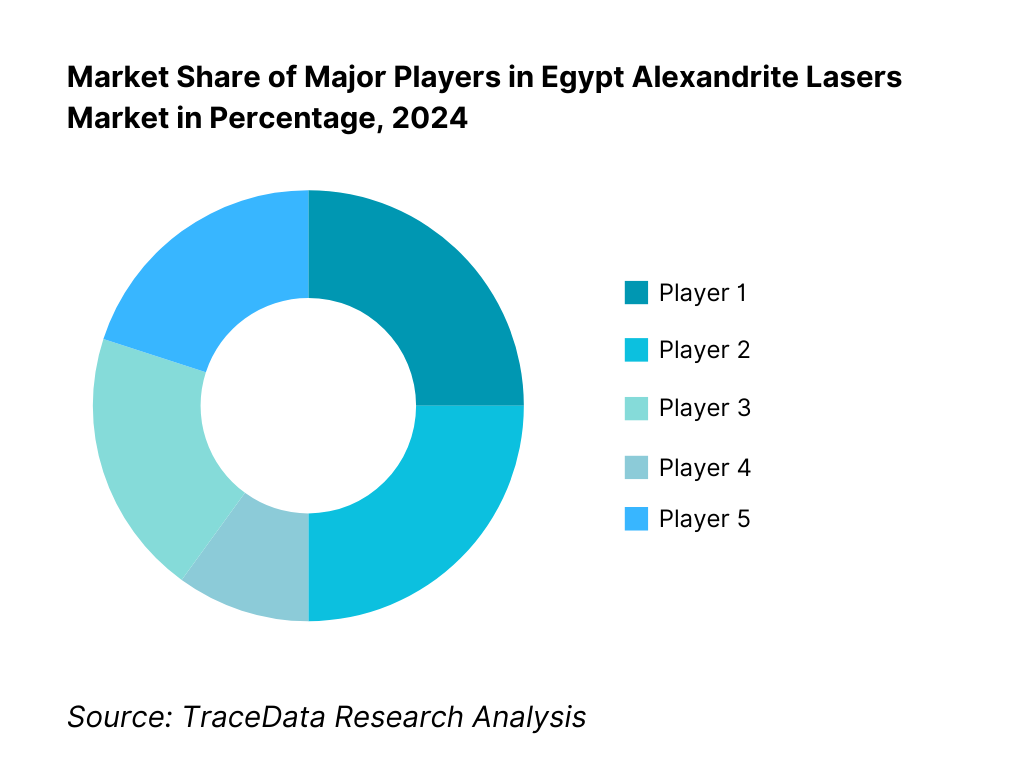
What Lies Ahead for Egypt Alexandrite Lasers Market?
The Egypt Alexandrite Lasers market is expected to continue its upward trajectory toward the end of the decade, supported by strong consumer demand for advanced cosmetic dermatology, the rise of medical tourism, and the expanding network of private clinics across Cairo, Alexandria, and coastal hubs. Growth will also be reinforced by improved regulatory clarity, financing models for device procurement, and the integration of AI-enabled laser platforms, ensuring the market evolves toward a more technology-driven and patient-centric ecosystem.
Rise of Dual-Wavelength and Hybrid Systems: The future of the Egypt Alexandrite Lasers market will be shaped by the adoption of dual-wavelength (755 nm + 1064 nm) and hybrid laser platforms, which offer clinics versatility in treating multiple indications. This transition is driven by demand for safer solutions on darker skin tones, which represent a significant portion of Egypt’s patient demographic.
Focus on Clinical Outcomes and ROI: As clinics and med-spas seek faster breakeven and higher patient satisfaction, outcome-based adoption will gain traction. Device choices will increasingly be guided by clinical efficacy, uptime, and post-treatment satisfaction scores, ensuring that investment in Alexandrite systems directly translates into higher session bookings and sustainable ROI.
Expansion in Tourism and Secondary Cities: Growth will not remain confined to Cairo and Alexandria; aesthetic services are likely to expand into Delta and Upper Egypt regions, as well as tourist hubs like Sharm El Sheikh and Hurghada. Medical tourism packages that combine leisure with cosmetic procedures are expected to become a key demand driver for Alexandrite laser systems.
Leveraging AI and Smart Technology: The integration of AI, skin-type detection, and analytics into Alexandrite laser systems is expected to rise, enabling personalized treatment settings and predictive maintenance. This will improve patient outcomes, reduce downtime, and allow clinics to manage large treatment volumes efficiently, making Egypt a regional hub for cutting-edge dermatology solutions.
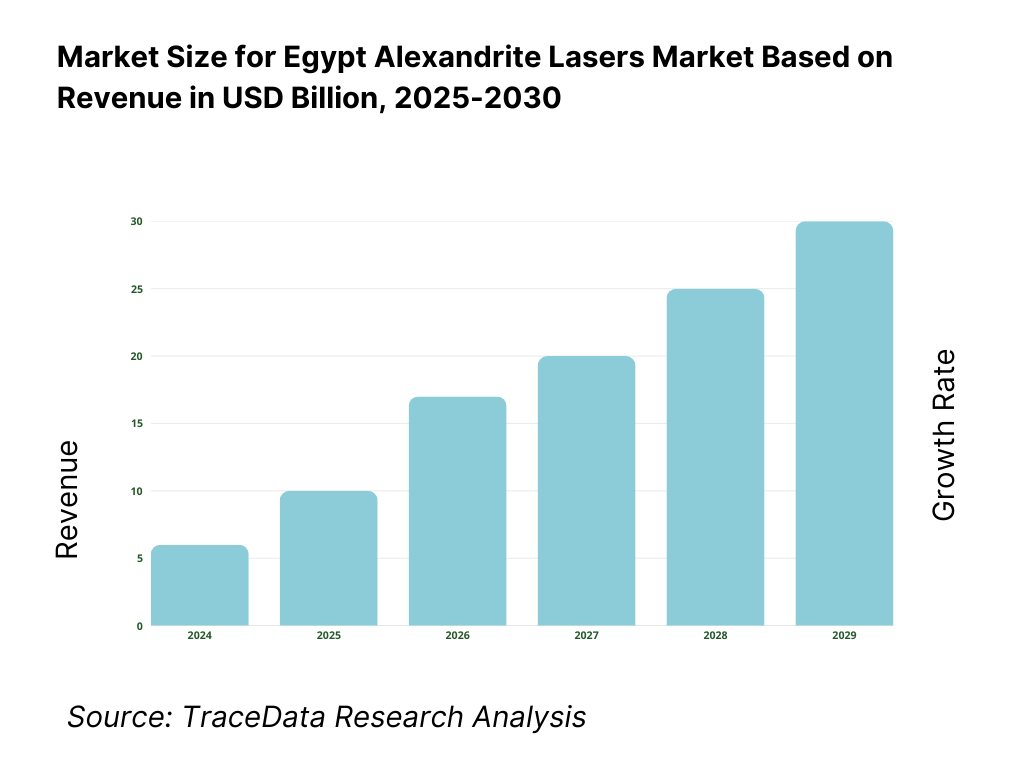
Egypt Alexandrite Lasers Market Segmentation
By System Type
Single-wavelength 755 nm Alexandrite Lasers
Dual-wavelength Alexandrite + Nd:YAG (755 nm + 1064 nm)
Q-switched Alexandrite Lasers
Picosecond Alexandrite Lasers
Hybrid/Platform Systems
By Application
Hair Removal
Pigmented Lesions (freckles, age spots, melasma)
Vascular Lesions & Leg Veins
Tattoo Removal
Skin Rejuvenation & Texture Improvement
By End User
Dermatology & Aesthetic Clinics
Multi-specialty Hospitals with Dermatology Units
Med-Spas & Cosmetic Centers
Chain Clinics / Franchise Aesthetic Networks
Teaching Hospitals & Training Institutes
By Price Tier
Premium Devices (advanced dual-wavelength & picosecond systems)
Upper-mid Segment (single + hybrid with advanced cooling)
Mid Segment (standard Alexandrite with core features)
Value Segment (entry-level, simplified platforms)
Refurbished / Secondary Market Units
By Financing / Ownership Model
Outright Purchase (Capex)
Leasing (long-term contracts)
Rental Models
Pay-per-shot Agreements
Revenue-share Partnerships with Clinics
By Region
Greater Cairo (Cairo, Giza)
Alexandria & North Coast
Nile Delta (Mansoura, Tanta, etc.)
Upper Egypt (Luxor, Aswan, Assiut)
Red Sea & Sinai (Sharm El Sheikh, Hurghada, Dahab)
Players Mentioned in the Report:
Candela
Cynosure
DEKA (El.En. Group)
Quanta System
Cutera
Lutronic
Lumenis
Asclepion
Lynton
WONTECH
Bison Medical
Light Age
Ilooda
Beijing Sincoheren
DDC Technologies
Key Target Audience
Private Aesthetic Clinic CEOs / Procurement Heads
Med-Spa Chain Owners / Financial Directors
Hospital Dermatology Department Heads
Medical Device Distributors & Importers
Lease & Financing Providers for Medical Equipment
Aesthetic Tourism Investment Funds
Investments and Venture Capitalist Firms
Government and Regulatory Bodies
Time Period:
Historical Period: 2019-2024
Base Year: 2025
- Forecast Period: 2025-2030
Report Coverage
Choose individual sections to purchase. Mix and match as you like.
- -
- -
4. Value Chain Analysis for Egypt Alexandrite Lasers Market
4.1 Delivery Model Analysis (Outright Purchase, Leasing, Pay-per-shot, Revenue-share)-Margins, Preference, Strengths, Weaknesses
4.2 Revenue Streams (Device Sales, Service Contracts, Consumables, Training Packages)
4.3 Business Model Canvas (Key Partners, Activities, Customer Segments, Value Proposition)
$1005.1 Authorized Distributors vs Grey-Market Importers
5.2 Investment Model in Egypt Alexandrite Lasers (Capex, Financing, Leasing)
5.3 Comparative Analysis of Public vs Private Procurement Funnel
5.4 Device Acquisition Budget Allocation by Clinic Size
$1506.1 Market Attractiveness Index (Application Potential, Patient Demand, ROI Speed)
6.2 Heatmap of Demand Intensity (Urban vs Tourism Hubs)
$1007.1 Installed Base vs Patient Load Gap
7.2 Unmet Needs in Regional Clinics (Delta, Upper Egypt)
$2008.1 Revenues (In USD Mn, Historical)
8.2 Installed Units and Utilization Rates
8.3 Session Volume Analysis (Average Treatments/Month per Clinic)
$3009.1 By Market Structure (Authorized Import, Grey-market Refurbished)
9.2 By Application (Hair Removal, Pigmented Lesions, Tattoo Removal, Skin Rejuvenation, Vascular Lesions)
9.3 By End User (Dermatology Clinics, Hospitals, Med-Spas, Chain Clinics, Teaching Institutions)
9.4 By Financing Model (Purchase, Lease, Rental, Revenue-share, Pay-per-shot)
9.5 By Price Tier (Premium, Upper-mid, Mid, Value, Refurbished)
9.6 By Region (Greater Cairo, Alexandria & Coast, Nile Delta, Upper Egypt, Red Sea & Sinai)
$40010.1 Clinic Client Landscape and Cohort Analysis (Boutique Clinics, Chains, Public Hospitals)
10.2 Decision-Making Process for Device Procurement (Clinical Effectiveness, ROI, Brand, Service)
10.3 ROI and Payback Analysis (Sessions Required to Breakeven)
10.4 Gap Analysis Framework (Installed Base vs Patient Potential)
$50011.1 Trends and Developments (Dual-Wavelength Uptake, Picosecond Adoption, AI Skin Typing Tools, Subscription Models)
11.2 Growth Drivers (Aesthetic Tourism, Female Workforce Growth, Rising Disposable Income, IPL Substitution)
11.3 SWOT Analysis (Egypt Alexandrite Lasers Market)
11.4 Issues and Challenges (Safety on Darker Skin Types, Service Cost Inflation, Skilled Operator Scarcity)
11.5 Government Regulations (Medical Device Registration, Import Compliance, Safety Protocols)
$20012.1 Market Size and Future Potential for Smart/Connected Alexandrite Lasers (Cloud Diagnostics, AI Integration)
12.2 Business Model and Revenue Streams (Remote Monitoring, Digital Training Packages)
12.3 Delivery Models and Course/Training Offerings for Operators
12.4 Cross Comparison of Leading Companies Based on Specs, Revenues, Installed Base, Service Network, Pricing, Cooling Technology
$500- $250
- $150
15.1 Market Share of Key Players (Revenues, Installed Units)
15.2 Benchmark of 15 Key Competitors (Candela, Cynosure, DEKA, Quanta, Cutera, Lutronic, Lumenis, Asclepion, Lynton, WONTECH, Bison, Light Age, Ilooda, Sincoheren, DDC Tech)-with Company Overview, USP, Business Strategy, Device Specs, Spot Sizes, Cooling Tech, Revenues, Service Footprint, Clients, Tie-ups, Marketing, Pricing, Developments
15.3 Operating Model Analysis Framework
15.4 Gartner Magic Quadrant (Positioning Global Alexandrite Laser OEMs)
15.5 Bowmans Strategic Clock for Competitive Advantage
$75016.1 Revenues (Projections in USD Mn)
16.2 Installed Base Growth Forecast
16.3 Patient Volume Projections
$30017.1 By Market Structure (Authorized Import vs Grey-market)
17.2 By Application (Hair Removal, Pigmented Lesions, Tattoo Removal, Rejuvenation, Vascular Lesions)
17.3 By End User (Clinics, Hospitals, Med-Spas, Chains, Teaching Institutions)
17.4 By Financing Model (Purchase, Lease, Revenue-share, Pay-per-shot)
17.5 By Price Tier (Premium, Mid, Value, Refurbished)
17.6 By Region (Cairo, Alexandria, Delta, Upper Egypt, Red Sea & Sinai)
$400- $250
- $250
Research Methodology
Step 1: Ecosystem Creation
We begin by mapping the ecosystem of the Egypt Alexandrite Lasers Market, identifying both demand-side and supply-side entities. On the supply side, this includes global OEMs (Candela, Cynosure, DEKA, Quanta, Cutera, Lutronic, etc.), regional distributors, importers, and service partners. On the demand side, we map dermatology clinics, hospitals, med-spa chains, and teaching hospitals that adopt Alexandrite platforms for aesthetic and dermatological procedures. Based on this ecosystem, we shortlist 5–6 leading suppliers active in Egypt by evaluating their import activity, distributor footprint, after-sales service capability, and installed device base across Cairo, Alexandria, and Red Sea hubs. Sourcing is conducted through regulatory filings, distributor listings, and government import data to collate industry-level information.
Step 2: Desk Research
An exhaustive desk research process is then carried out using secondary and proprietary databases, enabling a granular understanding of the Egypt Alexandrite Lasers Market. We aggregate insights around installed device volumes, number of dermatology/aesthetic providers, regional distribution of clinics, and regulatory approvals. This analysis is supplemented with company-level intelligence—covering distributor agreements, marketing initiatives, partnership announcements, and compliance with Egyptian Drug Authority (EDA) requirements. Sources such as import-export records, government trade data, Ministry of Health reports, and OEM disclosures are leveraged. Together, these inputs form the baseline view of revenue flows, financing models, pricing variations between premium and refurbished systems, and patterns of demand growth in high-tourism and urban centers.
Step 3: Primary Research
We execute structured interviews with senior stakeholders across the ecosystem—including dermatologists, clinic owners, biomedical engineers, distributors, and OEM regional managers. These discussions validate the desk research findings, authenticate financial and operational information, and provide deep insights into device utilization, ROI, and patient flow. A bottom-up approach evaluates revenue and unit contribution per supplier, aggregating to market totals, while a top-down approach benchmarks this against official trade and regulatory data. To strengthen validation, disguised interviews are also undertaken with distributors and clinic managers under the guise of potential clients. This enables us to cross-check service contract costs, average utilization rates, consumable expenses, and financing terms against what is publicly available.
Step 4: Sanity Check
Finally, we employ both top-to-bottom and bottom-to-top modeling exercises to ensure data consistency and accuracy. This includes reconciling import volumes with distributor sales, aligning installed base estimates with clinic density by region, and comparing patient treatment volumes with potential machine throughput. Market size models are stress-tested against tourism inflows, healthcare expenditure per capita, and EDA registration volumes. This multi-layered triangulation ensures a robust and validated assessment of the Egypt Alexandrite Lasers Market, capturing both macro-level trends and micro-level operational realities.
FAQs
01 What is the potential for the Egypt Alexandrite Lasers Market?
The Egypt Alexandrite Lasers Market is positioned for significant expansion, with the market valued at USD 48.7 million in 2023 according to international trade and treatment adoption data. Growth is being fueled by increasing demand for aesthetic dermatology treatments, particularly hair removal and pigmentation correction, supported by Egypt’s rising urban population of over 116 million people and its thriving medical tourism sector. The market’s potential is further bolstered by the widespread adoption of advanced technologies in Cairo, Alexandria, and Red Sea resort hubs, where patients seek safe, effective, and premium laser solutions.
02 Who are the Key Players in the Egypt Alexandrite Lasers Market?
The Egypt Alexandrite Lasers Market features several global OEMs with a strong presence through distributors and service networks. Key players include Candela, Cynosure, and DEKA, which dominate due to their advanced dual-wavelength systems and established reliability. Other notable competitors are Quanta System, Cutera, Lutronic, Lumenis, Asclepion, Lynton, WONTECH, Bison Medical, Light Age, Ilooda, Sincoheren, and DDC Technologies, all of which are expanding their footprint through authorized partners, training programs, and financing models tailored to the Egyptian clinic ecosystem.
03 What are the Growth Drivers for the Egypt Alexandrite Lasers Market?
The primary growth drivers include Egypt’s inbound tourism of 15.7 million visitors, many of whom demand premium cosmetic procedures, as well as a growing domestic middle class supported by USD 19.5 billion in remittances, which increase household spending capacity. Strong digital adoption with 73% internet penetration enables clinics to market treatments online and attract new clients, while universal electricity access (100%) provides the infrastructure needed to operate advanced Alexandrite systems reliably. These macroeconomic factors, combined with Egypt’s focus on modernizing private healthcare facilities, are driving adoption of Alexandrite platforms across urban and coastal cities.
04 What are the Challenges in the Egypt Alexandrite Lasers Market?
The Egypt Alexandrite Lasers Market faces several challenges, including regulatory hurdles related to device registration with the Egyptian Drug Authority (EDA) and import licensing, which can delay product launches. Foreign exchange shortages, reflected in a current account deficit of USD 20.8 billion, complicate procurement of high-value imported systems. Inflation pressures at 28.3% also constrain consumer spending on elective procedures and raise clinic costs for consumables and maintenance. Furthermore, the relatively low density of secure servers (82.2 per million people) compared to global averages poses data security and connectivity risks for clinics adopting AI-enabled and cloud-linked laser systems.